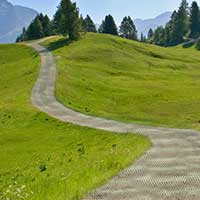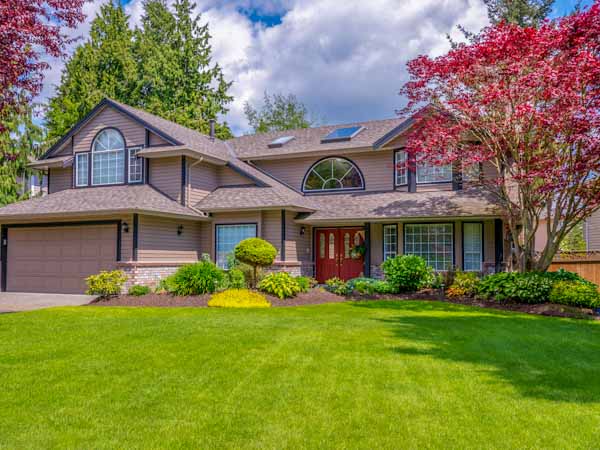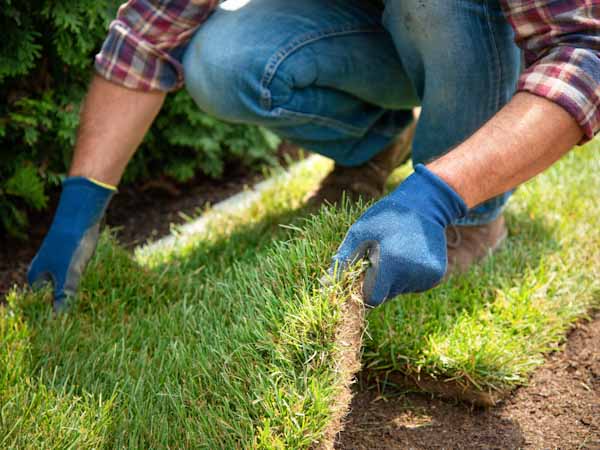Turf Protection Matting
FREE SHIPPING
Size: 6.7' x 25' (167.5 SF)
Roll Weight: 60 lbs
Our grass protection mesh is designed for demanding applications. The osculated mesh pattern provides a high degree of strength which is required to support the weight of a vehicle. Our mesh is ASTM lab tested to ensure strength and durability.
Do you require a formal quote for MudStop™ HG? Fill out the form at the link below and we will provide you with a written quote within two business days.
Request Formal QuoteDo you have product related or purchasing questions? We are happy to help, feel free to contact us.
Each Roll of MudStop™ HG requires 100 ground staples for proper installation. (sold separately)
How many rolls of MudStop™ HG do you need for your project? Just enter your square footage below:
"I Love the Heavy Duty Quality"
“Absolutely the best, least costly and less work solution to a turn a grassy area into an extra parking spot. I love the heavy duty quality and the way the green material looks. One $600 roll did the job with no digging/prepping needed. The alternative would’ve been $4300 for cement conversion or $2300 for gravel. The best part of it all: No permits required and can easily be converted back to just grass in the future.”
- Victor, Philadelphia, PA
Most heavy-duty grass protection mesh on the market is shipped in large 50’-70’ rolls which are very large, heavy and difficult to handle. When developing MudStop® HG we kept this in mind and decided to produce 25’ rolls which are much easier to handle and work with. A roll of MudStop® HG weighs 60 lbs and can be picked up and moved by one person instead of two. Additionally, due to the reduced roll length, smaller projects can be accomplished without having to purchase a bunch of extra material.


Low priced economy-grade mesh can provide basic reinforcement for very occasional vehicular parking. Where issues arise are in material durability and reduced traction. Due to its low strength, economy-grade mesh quickly deforms when driven on and will begin to rut out the grass underneath. Additionally, the low priced mesh is typically a flat mesh without ridges. This can create a slippery surface for pedestrians and vehicles when wet. MudStop™ HG incorporates an osculated mesh pattern to provide greatly enhanced material strength while its multi-layer design enables enhanced traction for both vehicles and pedestrians.
MudStop™ HG grass protection mesh can be installed in a wide variety of different landscape applications - pretty much anywhere you want protection against rutting from tires or foot traffic!










In addition to protecting grass from vehicular damage, MudStop™ HG can also be used to protect grass from becoming damaged in dog run areas. The osculated mesh pattern is engineered with small openings which keeps paws from getting stuck. Does your dog love to dig in your lawn? Our mesh will prevent that from happening as well. MudStop™ HG is the perfect solution to keep your lawn mud free and your dog with a safe place to run and play.
The installation of MudStop™ HG in a lawn area can easily be accomplished by the homeowner. Follow the simple 3-step process below to reinforce your lawn with MudStop™ HG for optimal protection of your lawn area:

First cut the grass area short so that the mesh can be applied as close to the root zone as possible.

Roll out the mesh on the grass’s surface.

Using 8" ground staples, affix the mesh to the ground’s surface placing 1 staple every 18 inches in all directions. (each 25' roll of MudStop™ HG requires approximately 100 staples) As a general rule of thumb, the more staples you use the more secure the mesh will be. Edges and seams may require additional staples depending on the installation site characteristics. While stapling, be sure to smooth out any bumps or bubbles in the mesh caused by an uneven grass surface.

You can now drive, park and walk on your reinforced lawn. Be sure to water the grass well to encourage appropriate grass growth through the mesh. This will help disguise the material and provide a more natural looking surface.
If you are parking an rv, boat or other heavy vehicle long-term on the mesh it is a good idea to double up the mesh where the wheels will directly rest. Over time a very heavy load concentrated on a single area can deform the mesh especially during heavy rainfall if the ground below becomes saturated. Adding a second layer of mesh will provide additional support and help to prevent indentation into your lawn from the vehicle tires.The best way to accomplish this is to install a 1-1/2’ square under the main mesh layer where each tire will rest.
MudStop™ HG is stocked and ships from our Kansas City distribution center. Orders typically ship within one business day. Shipping is free and most customers experience delivery within one week of order placement.
MudStop™ HG orders typically ship within one business day of order placement. Smaller orders of a couple rolls typically ship via UPS / Fedex while larger orders ship by LTL freight. If your order ship via LTL freight the delivery company will contact you prior to delivery to arrange a delivery window that works with your schedule.

Transit times on the map above are shown in business days and exclude weekends and holidays.
If you want to replace your lawn even though it's established, we have some tips to help you out. Before you can proceed with your project, you must measure the area of your lawn that you will be replanting so you will know how much seed, fertilizer, and additives, you are going to need. Keep in mind, length x width = square feet. Be sure to keep your notes in a safe place for future reference.
Before anything else, get your soil tested ahead of time so you will know what your soil requirements will be. You should get your soil tested one or two months before you start planning your lawn. Testing will take some time to complete, so give yourself time to get everything you will need when the results come back as well as other items or equipment you are going to need for a successful lawn.
Contact your local county extension office for the right location to send your test samples to. It's advised you use labs in your area for the best results. They will get other samples in different locations on your lawn for accuracy. They will pull soil from the top 6- 8 inches for correct results. The extension office is a department located in your county or university. These offices are conducted by experts in various fields including landscaping, crops, pests, and more.
One of the most important steps will be controlling weeds from your lawn. We have found that using one of the following methods in the fall then just wait for early spring to replant. You are the only one who can schedule this project.

Sod Installation
#1 – This method should give you some great weed prevention results when done properly. Use peat moss, some fine bark dust, or potting soil and place at a depth of 2-4 inches over the top of your soil. You will have an excellent top layer to plant the seeds and seal off any weeds you might find. This option could be more expensive but will give you great results. From these choices, fine dust is the most affordable, peat moss is the most expensive, and potting soil is middle of the road.
#2 – You can use a herbicide to kill off the weeds. It's a very effective approach that can be carried out in the least amount of time and is less expensive. That said, you must follow the directions on the label very carefully. If you choose herbicides, you need to spray the lawn for at least 3 days after regular mowing for good results. Wait for the recommended amount of time from the label and mow as little as possible. Remove the debris and save it for composting if you wish. Then repeat this process using a thatcher blade on the mower, removing all excessive debris. You can use Strait apple vinegar to control a lot of the weeds.
#3 – One of the best and safest ways to control weeds is using sheets of clear plastic by covering the entire area you are working on to kill whatever is growing there. This can be a little more expensive and time-consuming but the results for control will be great if done properly. You must cover the area completely for 6 to 8 weeks to kill the more established grass. After this time, remove the plastic and move on to the next step. Unfortunately, this step does not work well in the Northeast due to the cooler temperatures.
When working the soil, do not overdo it if the soil is wet. You could damage the soil and it will take a very long time to recover. Rule of thumb, take a handful of dirt and squeeze it in your fist. Hold your hand out straight and drop the dirt on a firm surface, if it remains in the form of a ball, the soil is too wet and should not be worked on until it starts to dry out. Loosen not more than one inch of soil using a cutter or tiller. Rake and level removing heavy debris. You can use peat moss or sawdust as long as it's clean of any weed seeds. Just apply only a 1/4” of cover then level it out using a leaf rake. If you need lime or gypsum this would be the perfect time to apply it. If you have it or can find pellet or granular lime, it will be much easier to apply. Spread it as evenly as possible. If you use a fertilizer spreader it will give you a uniform coverage and give you a good planting platform.
If you want to wait until spring to plant, stop at this point.
If you have issues with weeds in your lawn, this is a good time to take control. After you thatch, level, and apply additives, start watering the areas for planting. You have to keep the area moist for approximately two weeks but do not overwater. If the soil seems moist in the morning but dry in the afternoon, you will have to water it again. Do not use so much water that you cause pooling, it will drown the new seedlings of grass. You can let an area sit idle for 2 or 3 weeks and see if any surface weeds start to grow. If the temperatures are in the mid-50s or 60s for 7 to 10 days, and there are no signs of weeds, move on to the next step for top coating and be ready to plant.
After 2 weeks have gone by, you can repeat #3 again by covering the area with clear plastic sheets to control new weeds that have come to the surface. The plastic sheets should remain in place for 2 to 4 weeks, depending on the level of weed control you are looking for. This should be done during the growing season and it will take a good amount of patience on your part to get the rewards you are hoping for.

New Lawn in Yard
If you do not want to use the plastic sheeting again, try raking the weeds lightly using a leaf rake or pull them out using your hand or a hoe. Try not to disturb the soil any more than necessary as it could lead to more weeds.
You can use peat moss or sawdust 1/2” deep over the planting areas. It will seal some weeds under the soil or sawdust if not done before. This will give the new seeds a good growing platform. Level and smooth out the area using a leaf rake and you are ready to plant.
The time has come to plant your lawn. In the designed setting, use your fertilizer spreader. Seed the lawn in one direction back and forth applying half the seeds you will be using. Then seed your lawn in the opposite direction or crosswise using the other half of the seeds. Should you have any seeds left, set them aside if you need to touch them up later on.
Keep in mind, seeds should be shallow not deeper than the length of the seed. If you have to place seeds laying on top, that's okay. Keep in mind the rates we recommend are minimum while performance can be increased by using a higher rate.

Placing New Sod Down
You have to water over the next 2 to 3 weeks to keep the soil moist. In the morning if the soil looks dry on top, you have to water IT again. Do not let the water pool as it can create dead spots. You should water for shorter periods of time while establishing. Keep the moisture on the upper level of the soil where the seeds are planted. Once the seeds emerge you can cut back on watering and let the soil dry out a little bit as the plants become established.
For new lawns, you need to level and smooth out the soil and formed to your preference. Just make sure you have good topsoil over the clay or rocky subsoil. It's highly recommended you water the area the same as if it was planted 2 or 3 weeks earlier to get the weeds in the soil to grow.
Do Not overwater or you will create pooling. After a while, let the soil on top dry off and decide which method works best for you. (#1 through #3).
Once you have completed one of the methods, you should top coat by applying less than half an inch of peat moss or sawdust. Be sure the topcoat is clean of any weed seeds. This will give you a great seed bed that's somewhat free of weeds and will be very easy to work with.
When starting over and planting a new lawn takes time, Talk to a local lawn specialist if you need guidance and make sure to stock up on all the materials you might need.